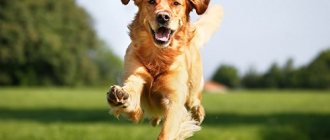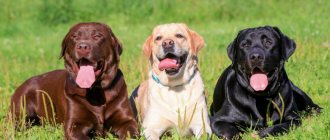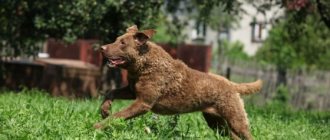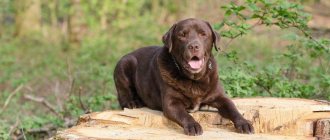- Pets
- >>
- Dog breeds
* Here is a photo of a typical representative of the Golden Retriever dog breed . You can send us photos of your animals by email, and we will post them on the website. Don't forget to send your pet's name.
Other breed names:
Golden Retriever
a brief description of
- Other names: Golden Retriever, golden, golden retriever, goldie.
- Height: adult male at the withers from 56 to 61 cm, females 51-59 cm.
- Weight: adult male no more than 34 kg, adult female up to 32 kg.
- Color: from pale cream to golden, but without a red tint.
- Coat: double-layered, long outer coat, soft and dense, dense undercoat with water-repellent properties.
- Life expectancy: from 10 to 12, rarely up to 14 years.
- Advantages of the breed: loyalty is inherent in nature. Has no ability to bite, is the best friend of children. It is used in programs for working with children with cerebral palsy and autism, as well as as a guide for deaf and blind people. Professional lifeguard and excellent swimmer. Participates in police projects to neutralize life-threatening objects, and acts in films.
- Difficulties of the breed: the dog is not endowed with protective qualities, is not able to bite or protect from attack.
- Price: average $500.
Golden Retriever dog breed: history of origin
The literal translation from English of the word retriever means “turned back.” In the description of the nature of the Golden Retriever breed, a separate paragraph notes the searching qualities of dogs that serve shot game to the hunter.
Scotland in the 19th century, a country of marshes, ponds and rivers, was famous for its hunting grounds and widely popularized the sport of hunting, in which the country's elite took part. The hunters were accompanied by dogs that flawlessly retrieved the prey, regardless of whether the game was shot on land or in water.
The history of the amazingly beautiful and selflessly devoted hunting dog was very mysterious, and therefore overgrown with numerous legends and myths. Some of them claimed that the dogs were the result of Lord Tweetmouth's experiments with Russian shepherds. Allegedly, the lord purchased eight pedigree individuals from the Russian circus, and from their litters the golden population was born.
A high-ranking Londoner and passionate hunter, Sir Dudley Majoribanks Tweedmouth was especially popular. In addition to hunting, the lord was engaged in breeding cattle, horses, and devoted part of his time to hunting dogs.
In 1910, the magazine Country Life published an article with the biography of Lord Dudley, where he did not refute the myth that had developed around dogs. The article, which delighted the ladies of the royal society, brought great success to dogs, but caused controversy in the canine community.
Much later, in 1952, the Lord's great-nephew confirmed the existence of stud books dating from 1835-90, and contributed his uncle's works to the already existing Golden Retriever Club under the leadership of Mrs. Stone. Thus, the last myth about the involvement of Russian Shepherds in breeding the breed was dispelled.
Stud books confirmed the litter was from a Tweed Water Spaniel bitch mated to a yellow English retriever. This was the beginning of breeding the glorious breed of Golden Retrievers, so popular today.
In the books, Ms. Stone discovered a note from Dudley himself, which mentioned the appearance of a yellow retriever in the lord's domain. The rare-colored dog was bought from a shoemaker, who in turn received it as payment of a debt from the royal forester.
A female straight-haired black retriever that belonged to a forester brought a single yellow puppy in the litter, which became a kind of payment for the money owed to the shoemaker. Having bought the puppy, the lord pursued the goal of obtaining a fawn retriever. Literally on the eve of the fateful meeting, the lord was presented with a female tweed water spaniel as a gift.
The mating of these two dogs in 1868 produced four yellow puppies, which formed the basis of the breeding program. After a while, some of the puppies were bred with a wavy retriever, some with a fawn blanhound, and the rest were used in mating with an Irish setter, known as a long-lived dog.
The litters were intelligently bred to consolidate the activity and power provided by the breed lines and increase the lifespan of the Golden Retriever, while maintaining great mental abilities and a high level of trainability.
So in 1903, the Kennel Club registered the first Golden. In 1908, the Golden Retriever took part in an exhibition show, and at the beginning of 1913, the Golden Retriever breed received official recognition from the international canine community.
In America, the breed gained recognition by 1925, and in 1938 a club was organized - first for amateurs, and later for professional breeders of the Golden Retriever breed. The breed was brought into the still existing USSR by A. Surov in 1989. He also organized the Russian Retriever Club, from where representatives of the breed dispersed to all corners of the CIS.
Purpose
The Golden Retriever has not been used for its intended purpose for a long time, but the dog has not lost its hunting skills, helpfulness and willingness to help people. Moreover, the retriever is considered the best companion dog , participating in many programs to help lonely people.
These are the best guides for the visually impaired population. Dogs perfectly perform the duty of rescuers in search operations in disaster zones to find people in the event of collapses of buildings and structures. These are the best therapists in the canistherapy program for working with children suffering from cerebral palsy and autistic children.
They are used in rehabilitation centers under the animal psychology program, since retrievers are able to tame aggression and relieve stress. A dog can comfort a crying person and cheer up a sad person. They also tend to help get out of a state of depression; they can save a drowning person without special commands or pull a person out of a burning house.
Deprived at the genetic level of aggression and the ability to bite, retrievers do not engage in fights with creatures similar to themselves. But if a golden dog is provoked by another dog for a long time, then, in the end, he will receive a harsh rebuff and will be expelled from the territory entrusted to him in disgrace.
Possessing fantastic obedience, dogs of this breed are ready to serve a person in all his endeavors. If you show the Golden how to do this, he will give you objects - bring a ringing phone, go to the nearest store for bread and coffee. They are very efficient.
If adults have forbidden swimming while on the shore of a reservoir, the golden will never let the child into the water. This is a breed that perceives all children as their own, be they human or feline offspring.
Dogs themselves make decisions based on the current situation, give an assessment and react to circumstances with lightning speed. Therefore, for the popular golden retriever breed, the price of a puppy from working parents is quite high.
Dogs are ideally trainable, distinguishing human speech, not intonation. In Europe, they are gladly hired by the police, thanks to their ideal sense of smell for finding weapons and explosives, and by customs officers, since the dog reads the psychological state and tension of a potential criminal.
In addition, dogs of the Golden breed have excellent acting skills, playing in films and starring in commercials, becoming popular movie characters.
Video
* We invite you to watch a video about the Golden Retriever . In fact, in front of you is a playlist in which you can select and watch any of 20 videos about a given dog breed by simply clicking on the button in the upper right corner of the window. In addition, the material contains quite a lot of photos. By looking at them you can find out what a Golden Retriever looks like.
In this article:
|
Rate the material!
[Total votes: 7 Average: 4.4]
Despite its noble origin the Golden Retriever is a very friendly and loving dog that dotes on children and gets along well with older people. Thanks to his agility and mobility, he is an excellent hunter, but in recent years, representatives of this breed have become more of a family friend than a hunting assistant.
Golden Retriever breed standard
Acceptable coat color is all shades from golden to cream without red. Dark golden, mahogany and chestnut colors are not acceptable. Unlike the English breed standard, which recognizes pale colors, the American standard allows for breeding goldens with wool of rich golden shades.
The appearance of the dog is distinguished by the harmony of the proportional structure of the skeleton. The dog must not only be beautiful in appearance, but must also captivate with the gracefulness of its confident movements. The look should express friendliness.
The powerful chest is given depth by well-arched ribs and the dog’s absolutely flat back. The croup and tail should form a single line. The American Golden Retriever breed standard allows for a slight sloping croup.
The front legs are muscular and straight. The length of the shoulder blade corresponds to the length of the humerus. Elbows tightly packed with shoulder blades pulled back. Running should consist of light movements with alternate throwing of the limbs far forward.
The hind legs are strong, muscular, and correctly set. The knee joint is well defined. When running, the pushing force is high, the paws are extended in a straight line.
The coat is straight with a dense undercoat, a slight wave along the croup is acceptable. On the neck, under the ears and around the head, the hair is longer than on the body and forms a mane, giving the dog a friendly appearance.
The size of a Golden Retriever has both lower and upper height limits. An adult male at the withers should not be lower than 56 cm and no higher than 61 cm. The parameters of an adult female should be no lower than 51 and no higher than 59 cm.
The Golden's head should feel firmly set and in harmony with the body. A rough, massive or sharp muzzle is not acceptable. It should be deep, wide, with a well-defined transition to the forehead. Medium-sized, down-hanging ears are set in line with the eyes.
The nose ends with a black large wide lobe. The eyes are dark brown, oval-shaped, widely spaced. The eyelids are dark, the expression of the eyes is kind. The jaws are strong with large teeth. A lack of teeth is not considered a defect, but it does affect the evaluation score. Scissor bite.
Golden Retriever: description of the breed and character traits
The wide historical popularity of goldens has led to differences in the appearance of representatives of the breed living on different continents. Thus, the American type is characterized by high legs and a rare white color, not recognized by the AKC.
British retrievers are stockier, and among the representatives you can often find a dog of a light, almost white color. The Canadian type is characterized by a dark coat, less dense than that of the British or Americans, slender posture and tall stature of goldens.
All dogs have the same life cycle, and how long a Golden Retriever lives in Britain is the length of a Golden Retriever’s life in Russia, Canada or America: up to 12, and if you’re lucky, up to 14 years.
All regional-continental representatives are united by the same character, which is considered a distinctive breed characteristic of goldens. Good-natured and flexible , dogs have a special zeal in their desire to bring joy to humans. The breed, specially bred to help people, has enormous potential, and the process of training and raising a dog brings considerable pleasure.
Reproduction and lifespan
This is not to say that golden retrievers do not live long. Usually, with good care, they live up to 12-13 years. To make the animal feel comfortable, it is recommended to feed it properly, take it to nature, play sports with it, etc.
The breeder of the breed is required to have accurate knowledge about it. He should not confuse the European and American retrievers. Only representatives of one group should be brought together. Dogs are bred in the male's territory.
This is usually done in the middle of the female's estrus period. A pregnant golden bitch becomes even more affectionate than she was before. Over the course of 70 days (plus/minus 3 days), she will especially need the attention of the owner breeder.
Choosing a puppy
The right first step in purchasing a golden puppy would not be a trip to the bird market, but a thorough analysis of offers from specialized nurseries for breeding golden retrievers. You should not be afraid of distances if there are no offers from factories nearby - after all, people travel hundreds of kilometers to find a good dog.
And this step is completely justified - it is not a toy or thing that is being purchased. A living being, intelligent and devoted, settles in the house. The dog must be healthy and fully comply with the breed qualities.
The next step is to arrange a viewing at the kennel where the Golden Retriever puppies, their mother and, possibly, the father of the Goldie family are kept. Seeing the parents and breeding dogs is very important. This is the only way to get an idea of what the puppy will look like when it grows up.
It is very difficult to get your bearings when a young herd of furry children runs out towards you. They are all good, and it is quite difficult for an inexperienced person to make a choice. Here the breeder’s help is invaluable, since he knows each baby from the first minutes of birth.
As a rule, all breeders are quite frank and literally “see right through” potential future parents. Only the breeder knows which of the dog's children is a couch potato and which is a big naughty one.
It is very important to get to a responsible and competent breeder. Yes, and you need to be frank with him - the dog is being purchased as a friend and companion or a show career is planned. Or maybe the dog is taken for breeding. This is where the owner of a dog breeding farm should help with his advice.
The room where the droppings are kept must be clean and tidy, and unpleasant odors are unacceptable. When choosing a puppy, you should pay attention to the activity and strength of the baby’s movements. He should be moderately agile and friendly. The puppy should wag its tail and not be afraid of visitors. Already at five weeks, these qualities are characteristic of small goldens - dogs created to help people.
If you are purchasing a grown-up puppy, you should find out about the habits that he has acquired by this age. Maybe he likes to chew on objects, look for and take away socks and toiletries. This happens often among goldens.
The best age to purchase is considered to be a seven-week-old puppy. But if this milestone is missed, breeders recommend bringing the puppy home at nine weeks of age, and do not recommend setting a moving date when the puppy is 8 weeks old.
Goldens have a specific psychological barrier associated with two months, which will be difficult to overcome. Let the puppy be a week before this milestone, or a week after the two-month mark.
How much does a Golden Retriever cost, whether the puppy is small or grown up – is stated by the breeder. The cost consists of a number of factors, among which the main ones are the title of the parents, the number of litters and the age of the puppy.
Titles indicate that experts recognize the correctness and beauty of the dog in accordance with the breed standard. Small puppies, as a rule, are cheaper than older ones, since the investment in their lives is small. And, let’s say, an 8-9 month old show-class puppy, with whom classes have already been carried out and he is assessed as promising, will cost very much if he can be purchased. As a rule, such dogs remain in the kennel.
If the future owner sees only a companion in a dog, it is better to take a small puppy and raise it according to the family way of life. If you are purchasing a dog for a show, it is best to find a mature puppy. If a dog is taken for breeding, then you should definitely buy a bitch, and the best one at that. To do this, you should invite an independent expert and a veterinarian to the show to obtain an opinion.
Names and nicknames for golden retriever
The dog's nickname is given at birth and is recorded on the dog's birth certificate - puppy. The entire litter will be named with the same letter, according to the stud book of the stud. But no one will forbid giving a pet a pet name that reflects character traits, and, perhaps, completely different from the nickname.
The main thing is that the name is capacious, sonorous, consisting of no more than three syllables, that the dog likes it and is easy to pronounce. As a rule, retrievers are given English-language names. They are often associated with Scottish mythology, but more often they are named after American movie characters or movie stars.
History of the breed
The history of the Golden Retriever is interesting and unique. The fact is that there are two versions of the origin and formation of the breed. One is very beautiful, looks more like a legend than a true story. The other version is more truthful and realistic. It is known for sure that the homeland of golden retrievers is Great Britain. If you are interested in these dogs, you should familiarize yourself with both the first and second versions of their origin:
The Legend of Lord Tweedmouth and the Golden Retrievers
In 1858, Lord Tweedmouth saw Russian shepherds perform at a circus performance. The four-legged artists amazed him not only with their beautiful appearance, but also with their intelligence and intelligence. The lord was known as a man who valued and collected in his estate everything that could be called beautiful, exotic, and unusual. Naturally, Tweedmouth bought eight dogs of the species he liked for a huge sum and began breeding them.
His unique estate, which is located next to Loch Ness Lake, has been replenished with an interesting breed, the representatives of which have gained great popularity among rich people.
On the territory of the Tweedmouth estate there was a park with exotic plants, a dairy farm with cows of the best dairy breeds, as well as hunting grounds. Among this fairy-tale setting, dogs with golden fur, unique intelligence and a circus history fit in perfectly.
The legend of circus Russian shepherd dogs, which, having moved to the lord’s estate, turned into elite pets belonging to the richest people, was of interest to everyone. It was unrivaled PR for the new breed.
Lord Tweedmouth even planned to go to Russia to buy some more Russian Shepherds. He voiced the version that the ancestors of his golden pets were Caucasian Shepherd Dogs. But there was not the slightest similarity between retrievers and Caucasians, either in appearance or in character.
For a long time, the circus legend about golden dogs was on everyone's lips. Fans of the breed wanted to believe in her. But soon a more truthful version refuted the story presented by Lord Tweedmouth.
History of the Golden Retriever, according to Tweedmouth Stud Books
To amateurs and ordinary people, the legend was quite true, but dog handlers understood perfectly well that this was just a fairy tale about golden dogs. It was necessary to establish the truth about the origin and ancestors of retrievers. After much searching and research, Elma Stoneks found written evidence of the formation of the breed.
The stud books kept by Lord Tweedmouth from the very beginning of breeding his goldens helped her figure it all out. Let's look at everything in order:
- Tweedmouth acquired his first golden retriever from a simple shoemaker who lived in Brighton. The puppy had a golden coat color. They called him Nous, which translated means “wisdom.”
- Nous, ripe for mating, was mated to a teacup spaniel. As a result, the couple had three yellow puppies. They became the founders of the breed.
- Bloodhounds and Irish setters participated in the formation of the breed. Black puppies born from such matings were strictly culled. Only golden and yellow ones were left.
- 1960 - Golden Retrievers were officially recognized as a separate breed.
- 1991 - the first Golden appeared in Russia.
Now golden is at the peak of its fame. These dogs have gained great popularity in almost all countries of the world.
Golden Retriever: care and maintenance
A beautiful dog is a healthy dog, and hair is considered the main indicator of a dog's health. Golden's coat needs regular and thorough care. Dogs are combed at least once a week to prevent the fur from becoming tangled and tangles forming.
Dogs shed profusely, especially in spring and autumn. During the molting period, they are brushed daily. Retrievers' coats take dry shampoos very well, and it is not recommended to bathe dogs frequently. Excellent swimmers, in the summer, retrievers themselves find a body of water to swim in.
Claws require care; they grow quite quickly and can cause pain in dogs. They should be trimmed frequently. The ears also need to be constantly inspected and cleaned. In active dogs, such as the Golden Retriever, the ears are susceptible to yeast bacteria that can cause ear infections of varying severity.
Goldies get along well in a house or apartment, but keeping a golden retriever outside is undesirable.
Loneliness has a bad effect on a dog's psychological state. She feels unfulfilled, and with the loss of her purpose - to be useful to people, Golden falls ill on a physical level, and his life is significantly shortened.
Possible diseases and methods of treating them
Fortunately, Golden Retrievers are in very good health. But any dog can get sick if it is not provided with proper care. It is better not to take a young representative of the breed outside until he has received all the necessary vaccinations.
The ideal option is to keep it at home for up to six months. If an unvaccinated purebred dog begins to walk on street soil and come into contact with other dogs, he can become infected and even die. Don't let this happen.
He has no specific diseases; even joint dysplasia appears extremely rarely in golden retrievers. But the dog’s health can suffer due to parasites. Helminthic infestation leads to intoxication of his body. The animal may begin to vomit, defecate frequently, and become less active.
Another clear symptom of his intestines being damaged by worms is itching in the anal area. A sick dog will always try to scratch itself to get rid of the discomfort. Therefore, every year give her deworming medication prescribed by your veterinarian. This is necessary for prevention. It would also be a good idea to regularly treat your fur for fleas.
Health and heredity
Goldens have a predisposition to cancer, transmitted genetically. Diseases of the musculoskeletal system are also considered hereditary. Almost every fifth retriever suffers from dysplasia of varying severity. Severe forms can be treated surgically, but this is a rather expensive procedure with a long rehabilitation process.
Based on the characteristics of the breed, the eyes of the Golden Retriever are also susceptible to diseases that are inherited.
When purchasing a puppy, it does not hurt to familiarize yourself with the health certificates of its parents, including ophthalmological examinations.
Remember that in the absence of medical examinations of the puppy’s parents, you can buy a “pig in a poke” and then treat a member of your family for a long time.
Not every dog has a breed predisposition to cardiac diseases, but, nevertheless, the development of subaortic stenosis can affect both an adult and a puppy. It is very important to examine the dog's heart at least once a year for the presence of murmurs to avoid sudden death.
All retrievers are prone to infections and hormonal imbalances. The infection mainly affects the ears. Hormonal imbalance occurs as a result of dysfunction of the thyroid gland, resulting in the dog developing hypothyroidism.
What to feed your Golden Retriever
Goldens are considered absolutely unpretentious creatures when it comes to food. They eat natural food and dry food with equal pleasure. With natural nutrition, it is important to correctly calculate the dog’s diet so that it can receive sufficient amounts of fats, proteins, carbohydrates and minerals.
Protein and fats must be balanced, since excess fat leads to damage to the pancreas, and excess protein leads to weight problems.
Therefore, the retriever's diet consists of 50% raw meat - lean beef or turkey, sea fish and cottage cheese. It is advisable to give fish three times a month, cottage cheese no more than once a week. A quarter of the diet consists of cereals - rice and buckwheat, the remaining 25% comes from vegetables and fruits.
A very important factor in the Golden Retriever breed is the weight of the dog. When feeding naturally, body weight must be regularly monitored, since goldens are prone to obesity, regardless of their temperament.
When dogs reach six months of age, by-products are introduced into their diet. At first, they should be given carefully, since by-products can cause digestive upset.
Until the age of five months, puppies are fed six to four times a day at the same time, evenly dividing the daily dose by the number of feedings. From six months of age to 8 months, the puppy receives food three times a day, and by the age of one year, an older dog is transferred to two meals a day.
We can safely say that the life expectancy of a Golden Retriever directly depends on the quality of food and maintaining a balance in the diet. Therefore, many owners feed their dogs super-premium dry food.
Special series of light and medicinal foods have been developed for the breed, and some manufacturers also produce special lines of food intended for retrievers. They contain a rich set of vitamins, the necessary percentage of glucosamine and chondroitin to support joints, as well as the Omega-3, 6, 9 complex, which has anti-carcinogenic properties.
A cheap type of food can provoke a food allergy in a golden dog, so you shouldn’t experiment with your dog’s health. But expensive types of food, especially if it is new to the dog, are introduced gradually, partially replacing it over the course of a week. The most optimal feeding for your pet is considered to be hypoallergenic food based on lamb meat.
What does lifespan depend on?
Hereditary predisposition is a criterion that determines the life expectancy of a dog.
Golden Retrievers have no hereditary complications. When purchasing a puppy, the breeder undertakes to tell you if diseases may have been passed on to his parents. A lot depends on the owner of the dog. The animal needs careful attention and care:
- Nutrition - meat and offal must be fresh, food must be of high quality.
- Healthy atmosphere - if you live in the city, you should walk your pet in the park, and on weekends go outside the city as often as possible.
- Physical activity - the retriever will enjoy frequent walks, games, and training.
- Veterinary control - the pet’s health should be monitored from early childhood.
- Attention - it is important to monitor the dog’s well-being and mood; he will not be able to report any discomfort.
- Medical services - deworming, protection against ticks, fleas, vaccinations against diseases.
- Sterilization - protects against reproductive diseases, reduces the risk of early mortality due to pregnancy and childbirth in bitches.
Training
Golden Retriever puppies are highly active and playful, athletic creatures. As soon as the little golden crosses the threshold of the apartment, they should start training. From the very first days of their arrival in the house, dogs need physical exercise.
If the pet was purchased during the warm period of the year, then after quarantine it needs to be introduced to the pond. Natural swimmers, retrievers simply adore water and will happily run and swim.
For a dog, work is pleasure. For a golden dog, doing something to please its owner is considered the meaning of life, and praise from a person is the pinnacle of happiness. It is very important for them to get a mental challenge, an intellectual game or an interesting, difficult task in order to feel fulfilled and needed by the person. This is the most powerful stimulating factor in raising a Golden.
For the Golden Retriever breed, training is considered one of the types of intellectual charades that must be performed with honor. The dogs enjoy exercising. Obedience is practiced quickly, since the dog itself wants to be able to control itself.
Many, having heard that the breed is quite smart, neglect their classes, thereby impoverishing the dog’s life.
Education and training
The characteristics of this breed allow it to quickly learn various skills. You can start training your puppy at two months old. Until six months, the owner must independently teach him the following:
- Walk with a collar and leash.
- Obey all family members.
- It is good to follow the commands “Fu”, “Nearby”, “Place”, “Come to me”.
- During walks, stay close to the owner, do not pick up various objects from the ground, and do not cling to passers-by.
Dogs of this breed easily master the commands “Fetch”, “Voice”, “Quiet” and many others. If the owner cannot cope with teaching these skills on his own, it is advisable to give the pet to a dog handler.
Golden Retriever: pros and cons of the breed
A large hunting dog with a high level of intelligence and a surprisingly obedient character has become an integral part of everyday life for humans. The popularity of the breed came as quickly as applications for its unique canine qualities were discovered.
This is a guide for the visually impaired and a lifeguard on the waters, a therapist for children with cerebral palsy and autism, a police bloodhound and a gentle nanny for growing offspring, a companion for a pensioner and a spectacular movie actor.
This is the third most popular breed among Americans, who believe that a typical family in the United States consists of parents, a couple of children and a Golden.
Over the entire period that Golden Retrievers have been living among people, there has not been a single case of criticism of the breed. The dog’s gentle character and cheerful disposition are captivating, and innate sense of optimism makes them unsurpassed pets in homes with small children or in families where they are preparing for the birth of another baby.
Adult dogs have tact and are able to evoke a sea of positive emotions. If a young retriever is naughty, then he will most likely lose his temper and sleep not in his usual place, but hidden away from the eyes of his owner.
And yet, Goldie perceives a person as a comrade, extending her positive attitude towards life to him. Retrievers are also very clean. As a puppy, the dog quickly figures out where to go and will ask to go out so as not to make a mess in the house.
Surprisingly, goldens have an excellent memory. Dogs are capable of remembering events that happened many years ago. Each mating of a male dog remains in his memory, and he retains tender feelings for his brides. Girls remember all their canine friends, starting from puppyhood, and express their emotions very violently when meeting old friends.
The disadvantages of the breed include a number of breed diseases and a tendency to infectious diseases. It’s amazing, but in some cases the dog’s sociability is put on a par with the disadvantages of the Golden Retriever breed; the price of the dog also falls into the category of breed disadvantages.
Goldens have a hard time forgiving betrayals and have a hard time getting used to a new family as adults. They can be destructive, but this is only in the case of a complete lack of education. Also, a dog should not be left alone for a long time - its character deteriorates, and the longer the dog is alone with itself, the more damage will be done to the surrounding space. This is how retrievers express their negative emotions.
And the last minus of the breed is that they are not guards. Golden retrievers raise their voice at a stranger, but the goldenie will not allow himself to use his teeth, even if the enemy shows aggression. The dog is more likely to walk away from a fight than to cling to its place in the sun, because the purpose of this breed lies in a completely different area.
Character
Experienced breeders know that the most important parameter that shows how happy and pleasant the union of a person and a dog will be is character. The Golden Retriever is by nature quite good-natured and affectionate. Unlike many dogs, he does not single out one person in the family, whom he recognizes as the leader. He loves all family members equally and is devoted to them to the last drop of blood.
He loves children very much and will be happy to spend his whole life playing with them. And the lifespan of a Golden Retriever is usually at least 10 years.
The breed is practically unfamiliar with aggression. Of course, there are overly cruel and evil representatives, but in most cases this is explained by errors in upbringing, frequent beatings and cursing on the part of the owner. The dog is simply trying to survive, protecting itself from violence.
Because of this, a retriever will not make a good guard. No, he will bark enthusiastically at a stranger if he tries to break into the house. But most likely, he will refuse to attack him - representatives of this breed are happy to live in peace with every person in the world.
They do not strive to dominate, calmly occupying the dog’s assigned niche in the family - they do not have to constantly live in tension, readiness to show the pet who is boss, as is the case with many other breeds. Well, this is an added plus for families getting a dog for their children.
Reviews
Olga Potapenko:
The movie "Marley and Me" is true. A bundle of positivity, a source of energy - how else can you express your feelings for a creature whose presence in the family stopped even the smallest quarrels. And as soon as you hug the Elephant, all your problems simply disappear.
Maksim:
The most sociable companion. In addition, he is a licker and a scoundrel, but well-mannered, kind and terribly positive. This is the best breed.
Elena:
The best nanny for my children. Excellent to train, loves to go for walks, but hates leashes. He always walks next to us, not paying attention to anyone. I think that over time the older child will be able to walk the dog on his own.
Marina:
Books should be written about this breed. A short review cannot express what a dog deserves. She is everything to me, or probably a little more.
We are waiting for your feedback about this amazing breed, lively, extraordinary, experiencing true love for humans. About character traits and irrepressible energy. About what prompted you to purchase a Golden, about your first meeting. We welcome comments left at the bottom of the article.
Share
Leave a review











